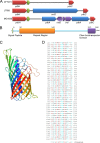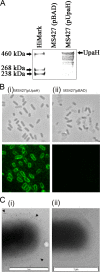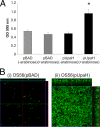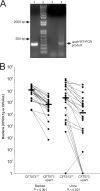UpaH is a newly identified autotransporter protein that contributes to biofilm formation and bladder colonization by uropathogenic Escherichia coli CFT073
- PMID: 20145097
- PMCID: PMC2849410
- DOI: 10.1128/IAI.01010-09
UpaH is a newly identified autotransporter protein that contributes to biofilm formation and bladder colonization by uropathogenic Escherichia coli CFT073
Abstract
Escherichia coli is the primary cause of urinary tract infection (UTI) in the developed world. The major factors associated with virulence of uropathogenic E. coli (UPEC) are fimbrial adhesins, which mediate specific attachment to host receptors and trigger innate host responses. Another group of adhesins is represented by the autotransporter (AT) subgroup of proteins. In this study, we identified a new AT-encoding gene, termed upaH, present in a 6.5-kb unannotated intergenic region in the genome of the prototypic UPEC strain CFT073. Cloning and sequencing of the upaH gene from CFT073 revealed an intact 8.535-kb coding region, contrary to the published genome sequence. The upaH gene was widely distributed among a large collection of UPEC isolates as well as the E. coli Reference (ECOR) strain collection. Bioinformatic analyses suggest beta-helix as the predominant structure in the large N-terminal passenger (alpha) domain and a 12-strand beta-barrel for the C-terminal beta-domain of UpaH. We demonstrated that UpaH is expressed at the cell surface of CFT073 and promotes biofilm formation. In the mouse UTI model, deletion of the upaH gene in CFT073 and in two other UPEC strains did not significantly affect colonization of the bladder in single-challenge experiments. However, in competitive colonization experiments, CFT073 significantly outcompeted its upaH isogenic mutant strain in urine and the bladder.
Figures






Similar articles
-
Functional heterogeneity of the UpaH autotransporter protein from uropathogenic Escherichia coli.J Bacteriol. 2012 Nov;194(21):5769-82. doi: 10.1128/JB.01264-12. Epub 2012 Aug 17. J Bacteriol. 2012. PMID: 22904291 Free PMC article.
-
Molecular characterization of UpaB and UpaC, two new autotransporter proteins of uropathogenic Escherichia coli CFT073.Infect Immun. 2012 Jan;80(1):321-32. doi: 10.1128/IAI.05322-11. Epub 2011 Sep 19. Infect Immun. 2012. PMID: 21930758 Free PMC article.
-
Functional analysis of antigen 43 in uropathogenic Escherichia coli reveals a role in long-term persistence in the urinary tract.Infect Immun. 2007 Jul;75(7):3233-44. doi: 10.1128/IAI.01952-06. Epub 2007 Apr 9. Infect Immun. 2007. PMID: 17420234 Free PMC article.
-
Virulence factors of uropathogenic E. coli and their interaction with the host.Adv Microb Physiol. 2014;65:337-72. doi: 10.1016/bs.ampbs.2014.08.006. Epub 2014 Nov 4. Adv Microb Physiol. 2014. PMID: 25476769 Review.
-
A systematic review and meta-analysis of antibiotic resistance patterns, and the correlation between biofilm formation with virulence factors in uropathogenic E. coli isolated from urinary tract infections.Microb Pathog. 2020 Jul;144:104196. doi: 10.1016/j.micpath.2020.104196. Epub 2020 Apr 10. Microb Pathog. 2020. PMID: 32283258
Cited by
-
Identification of genes important for growth of asymptomatic bacteriuria Escherichia coli in urine.Infect Immun. 2012 Sep;80(9):3179-88. doi: 10.1128/IAI.00473-12. Epub 2012 Jul 2. Infect Immun. 2012. PMID: 22753377 Free PMC article.
-
Reaching the End of the Line: Urinary Tract Infections.Microbiol Spectr. 2019 May;7(3):10.1128/microbiolspec.bai-0014-2019. doi: 10.1128/microbiolspec.BAI-0014-2019. Microbiol Spectr. 2019. PMID: 31172909 Free PMC article. Review.
-
Functional heterogeneity of the UpaH autotransporter protein from uropathogenic Escherichia coli.J Bacteriol. 2012 Nov;194(21):5769-82. doi: 10.1128/JB.01264-12. Epub 2012 Aug 17. J Bacteriol. 2012. PMID: 22904291 Free PMC article.
-
Did I pick the right colony? Pitfalls in the study of regulation of the phase variable antigen 43 adhesin.PLoS One. 2013 Sep 5;8(9):e73568. doi: 10.1371/journal.pone.0073568. eCollection 2013. PLoS One. 2013. PMID: 24039985 Free PMC article.
-
Comparative genomics reveals new single-nucleotide polymorphisms that can assist in identification of adherent-invasive Escherichia coli.Sci Rep. 2018 Feb 9;8(1):2695. doi: 10.1038/s41598-018-20843-x. Sci Rep. 2018. PMID: 29426864 Free PMC article.
References
-
- Anderson, G. G., J. J. Palermo, J. D. Schilling, R. Roth, J. Heuser, and S. J. Hultgren. 2003. Intracellular bacterial biofilm-like pods in urinary tract infections. Science 301:105-107. - PubMed
-
- Benz, I., and M. A. Schmidt. 1992. AIDA-I, the adhesin involved in diffuse adherence of the diarrhoeagenic Escherichia coli strain 2787 (O126:H27), is synthesized via a precursor molecule. Mol. Microbiol. 6:1539-1546. - PubMed
Publication types
MeSH terms
Substances
Associated data
- Actions
LinkOut - more resources
Full Text Sources

